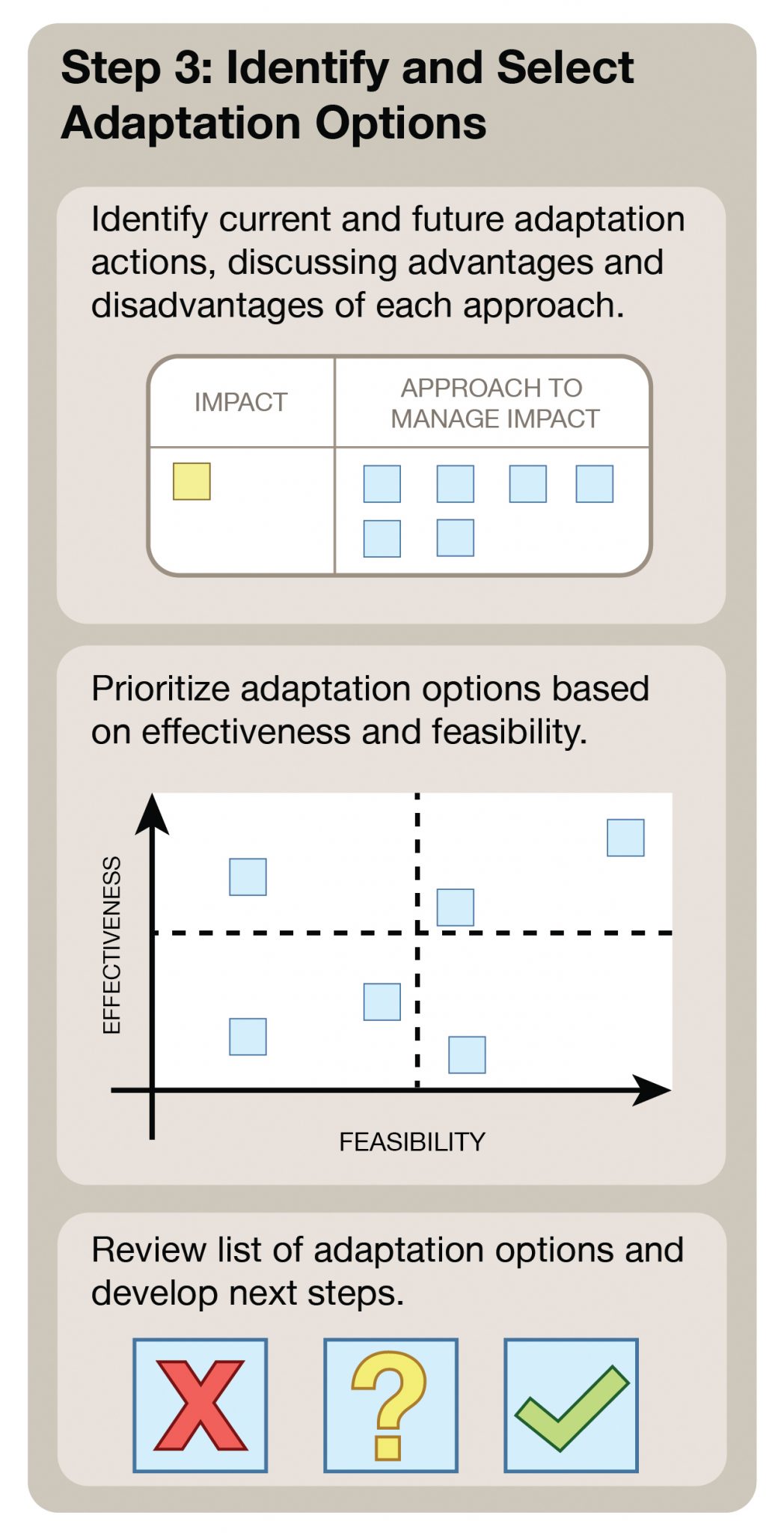- Heritage 101
- Advocacy
- Accessibility for Historic Places
- Climate & Sustainability
- Cultural Maps
- Heritage Place Conservation
- Heritage Policy & Legislation
- Homeowners
- Intangible Cultural Heritage
- Reconciliation
- Indigenous Cultural Heritage
- Setting the Bar: A Reconciliation Guide for Heritage
- 1. Heritage and Reconciliation Pledge
- 2. Acknowledging Land and People
- 3. Celebrating Days of Recognition and Commemoration
- 4. With a Commitment to Learn
- 5. Committing to Strategic Organizational Diversity
- 6. Mission-Making Room for Reconciliation
- 7. Possession, Interpretation, Repatriation and Cultural Care
- 8. Shared Decision Making
- 9. Statements of Significance and other heritage planning documents
- 10. Heritage Conservation Tools, Local Government Act
- Racism: Do Not Let the Forgetting Prevail
- Taking Action: resources for diversity and inclusion
- Webinars On-Demand
Step 3: Identify and Select Adaptation Options

In this step, you will consider your options for addressing the impacts identified in Step 2. Have a look at the sample decision-making flowchart for an example of how to think through possible adaptations. We have also provided multiple sources of information on possible adaptations and best practices.
Jump to:
Introduction: Climate Adaptation – Framework and Implementation
Step 1: Building a Strong Foundation
Step 2: Assess Vulnerability and Risk
Step 3: Identify and Select Adaptation Options
Steps 4 and 5: Implement Adaptation Actions, Monitor and Evaluate
Climate Adaptation Worksheet – download
Identify current and future adaptation actions, discussing the advantages and disadvantages of each approach.
- What actions are you currently taking to mitigate impacts? Are they having the desired outcome? What are the advantages and disadvantages?
- Are the actions supported by the Standards and Guidelines for the Conservation of Historic Places in Canada? (link)
- Are your actions supported by Building Resilience: Practical Guidelines for the Sustainable Rehabilitation of Buildings in Canada (link)
- What adaptation actions could you take to mitigate impacts? What would the outcomes of each adaptation be? What are the advantages and disadvantages? Think immediate as well as mid and long-term, taking into account potential domino effects.
Prioritize adaptation options based on effectiveness and feasibility.
- Which adaptations will be the most effective for your site?
- What is feasible to accomplish with the funding, time, and expertise you have now?
- What could you accomplish in 5 years? 10 years? 15 years?
- Would it be more cost and time-effective to complete some adaptations at the same time? For example, if the roof is being replaced it may make sense to add appropriate insulation at the same time and/or create a pipe system to drench the roof in case of wildfire.
- Does the effectiveness of some adaptations depend on other adaptations? For example, adding a storm window for increased energy efficiency and insulation will not have the desired effect if the window sill and frame are deteriorated and not repaired at the same time.
Review a list of adaptation options and develop the next steps.
- What options are the most feasible and effective for each impact, and should be implemented?
- What options could be implemented, depending on future research?
- What options are not feasible or effective, and should not be implemented?
- Are any actions currently being taken that should be stopped?
The Parks Canada climate adaptation framework and our accompanying workbook will guide you and your team in developing a comprehensive action plan. However, there may be times you want the support of someone with more experience or access to information. If this is the case, contact Heritage BC and we will help to identify a heritage consultant who will suit your needs and situation. You may also want to review the list of consultants on the BC Association of Heritage Professionals webpage (here).
Sample Adaptation Identification Process
This sample considers potential adaptations to mitigate the impact of more extreme winters. Please note that it is not exhaustive and is not specific to any one site. What you identify and the actions you choose will be specific to your situation, your access to expertise and materials, the available funding and time to undertake the work, and so on.
In this scenario, we consider the coldest or most exposed parts of the site.
Windows
- Are the windows single pane?
- Install a storm window.
- Are any of the panes damaged?
- Repair any damaged panes.
- Are any elements damaged or deteriorated, including tracing, mullions, sills, and sashes?
- Repair all damaged or deteriorated elements, either by fully replacing with like materials or repairing and filling the damaged portions.
- Are there any draughts?
- Install weather stripping. Make sure the adhesive will not damage the sill or frame and can be easily removed if needed.
Doors
- Are any parts of the door damaged or deteriorated?
- Repair or replace all damaged and deteriorated elements.
- Is there a gap between the door and the floor, or around the sides?
- Raise the threshold (only do this if it will not impact accessibility); and/or
- Add weather stripping. Make sure the adhesive will not damage the sill or frame and can be removed if needed.
The Main Floor
- Are any exterior walls damaged, inside or out?
- Repair all damage. It may be necessary to entirely replace exterior cladding or siding or change the material if necessary to hold up to more extreme conditions. If changing the materials, make sure to follow the Standards and Guidelines (here).
- Is there insulation in the walls, floors or ceiling? What is the condition?
- Add insulation if there is none or very little. Ensure the insulation will not disrupt the moisture barrier/flow. Cellulose, for example, can be a good option for buildings that need to breathe.
- If the insulation is damaged, find the source of the damage and repair it before replacing the insulation (i.e., damage caused by a leaking roof).
- What is the heat source?
- Is it sufficient for the building’s needs and uses? Is it wasting energy? Consider changing to a more effective and efficient option, such as a heat pump.
- Is there a basement? What is the foundation type?
- If the building has no foundation, consider raising it on one.
- Wood and dirt foundations and basements can be less stable, and may shift or deteriorate with heavy snow melt, for example. Concrete foundations may not be as warm. Consider reinforcing or insulating the basement.
- Repair any damage to the foundation.
- Evaluate the drainage around the structure. If snow melt and storms are causing drainage issues, install a drainage system or update and/or repair the current system. This could include utilizing gravel or other materials around the structure, installing pumps or pipe systems, changing the grade of the site, or digging ditches.
Upstairs
- Are any exterior walls damaged, inside or out?
- Repair any damage. It may be necessary to entirely replace exterior cladding or siding or change the material if necessary to hold up to more extreme conditions. If changing the materials, make sure to follow the Standards and Guidelines.
- What is the condition of the roof? Is it suitable for the amount of snow or storms that are projected?
- Repair any damage or deterioration. This may require replacing the whole roof, or could just be patching.
- Consider if the roof material is the best choice. A different material may be more storm resistant or insulating. If changing the materials, make sure to follow the Standards and Guidelines.
- Consider if the roof can hold up to the snow or storms. Consider creating extra supports and barriers for leaks. It may be necessary to ensure access to the roof during winter to clear it, depending on roof pitch and snow accumulation.
- Ensure all gutters and soffits are clear and in good repair every fall. Repair any damage right away.
- Evaluate the gutter system to ensure that downspouts are pointed away from the structure and that all slopes and materials (i.e. dirt vs pavers) are accounted for. Change the position or direction or downspouts if necessary. Eliminate any unnecessary bends or joints.
- Is there any insulation in the walls, floors or roof? What is it’s condition?
- Add insulation if there is none or very little. Ensure the insulation will not disrupt the moisture barrier and flow. Cellulose, for example, can be a good option for buildings that need to breathe.
- If the insulation is damaged, find the source of the damage and repair it (i.e., caused by a leaking roof). Replace the insulation.
- What is the heat source?
- Is it sufficient for the building’s needs and uses? Is it wasting energy? Consider changing to a more effective and efficient option, such as a heat pump.
- Is it losing heat on the way to the upstairs? There may be a better routing possible, or a way to add supplemental heat if necessary (i.e., a space heater or wood stove). It may also be possible to insulate the pipes or system.
A specific room
- Are any exterior walls damaged, inside or out?
- Repair any damage. It may be necessary to entirely replace exterior cladding or siding or change the material if necessary to hold up to more extreme conditions. If changing the materials, make sure to follow the Standards and Guidelines.
- Is there any insulation?
- Some rooms may not be insulated even though the rest of the building is. Add insulation if there is none or very little. Ensure the insulation will not disrupt the moisture barrier and flow. Cellulose, for example, can be a good option for buildings that need to breathe.
- If the insulation is damaged, find the source of the damage and repair it (i.e. a leaking roof). Replace the insulation.
- What is the room’s position and outlook? I.e. a north corner room may be colder, or one that doesn’t get any sun because of nearby trees.
- Trimming trees and hedges, or even moving them, can make a difference. If moving or cutting down a tree, make sure that the building will not be exposed to winds or storms as a result.
- Adding trees to serve as a windbreak may also make a difference. This depends on the room and the site as a whole.
- What is the heat source?
- Is it sufficient for the building’s needs and uses? Is it wasting energy? Consider changing to a more effective and efficient option, such as a heat pump.
- Is it losing heat on the way to the room? There may be a better routing possible, or a way to add supplemental heat if necessary (i.e. a space heater or wood stove). It may also be possible to insulate the pipes or system.
